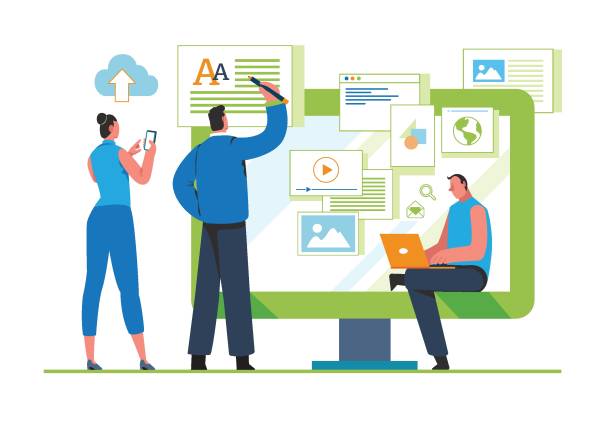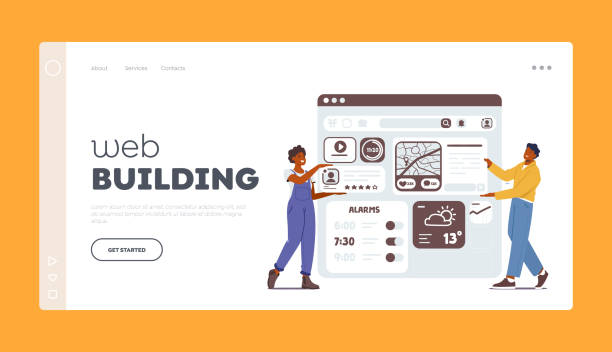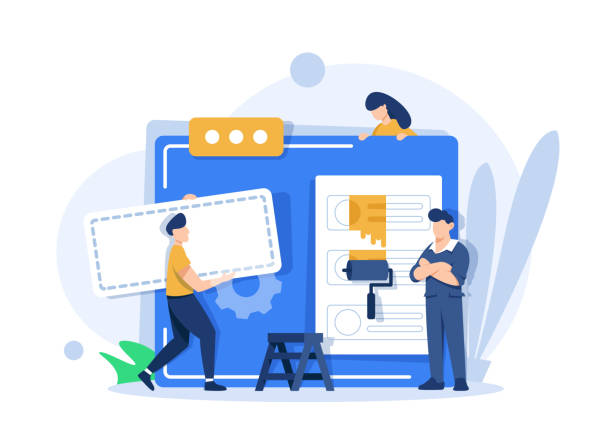The Importance of Modern UI Website Design in Today’s World
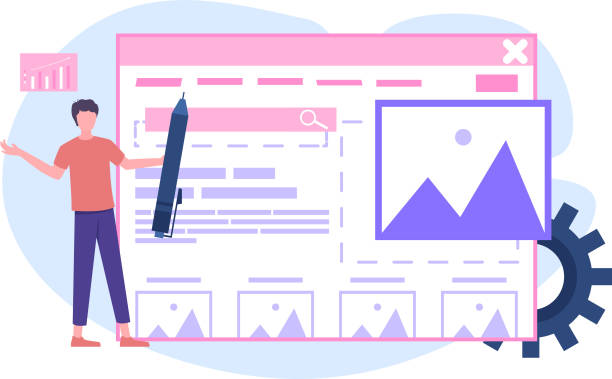
In the current digital age, where users quickly switch between different websites, modern UI website design is no longer a luxury choice but an undeniable necessity.
This not only directly impacts User Experience (UX), but also overshadows the overall success of an online business.
A website with modern #UI/UX design must not only be visually #appealing, but also provide a #simple, #smooth, and #efficient path for users to achieve their goals.
From the first moment a user enters the site until they decide to make a purchase or use services, every detail of the User Interface (UI) design must engage and guide them.
This includes the use of #whitespace, readable #typography, #harmonious colors, and #logical arrangement of elements.
The main goal is for the user to feel comfortable and satisfied and to reach what they want without confusion.
Disregarding these principles can lead to high bounce rates and the loss of potential customers.
Therefore, any investment in optimizing user experience and user interface is an investment in the future of the business.
Are you bothered by losing customers due to your online store’s outdated appearance or slow speed? Rasaweb’s expert team solves these problems with professional e-commerce website design!
✅ Increase customer trust and your brand’s credibility
✅ Stunning speed and excellent user experience
Get a free consultation with Rasaweb right now ⚡
Fundamental Principles in Modern User Interface Design
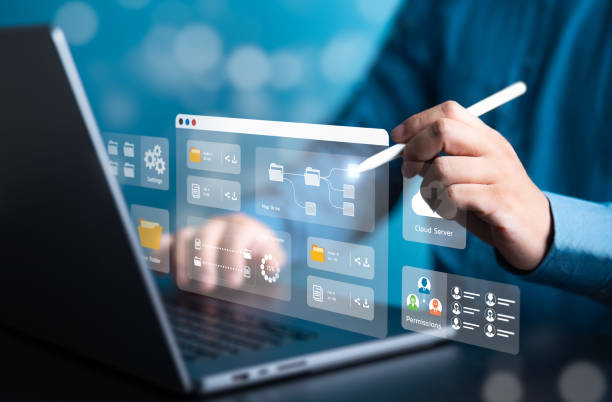
When addressing modern UI website design, several key principles must be observed.
First, Responsive Design.
Your website must display well and function correctly on any screen size, from small mobiles to large desktops.
This means full compatibility of content and elements with different device dimensions.
Second, simplicity and minimalism.
A modern user interface should not be overly cluttered.
Removing unnecessary elements and focusing on the main content helps users understand the site’s main message faster and reduces confusion.
Whitespace plays a vital role in this regard, as it allows visual elements to “breathe” and increases readability.
Third, Usability.
Users should be able to navigate the site easily and perform their tasks without needing complex instructions.
This includes clear menus, recognizable buttons, and simple forms.
Fourth, consistency and stability.
UI elements should be uniform throughout the site; for example, Call-to-Action buttons should always have a specific shape and color so users become accustomed to them.
Fifth, visual feedback.
When a user performs an action (such as clicking a button or filling out a form), the system should provide appropriate feedback to assure the user that their action was successful.
Adherence to these principles is the foundation of a user-friendly and effective web design.
Deep Understanding of the Audience for a Successful Design
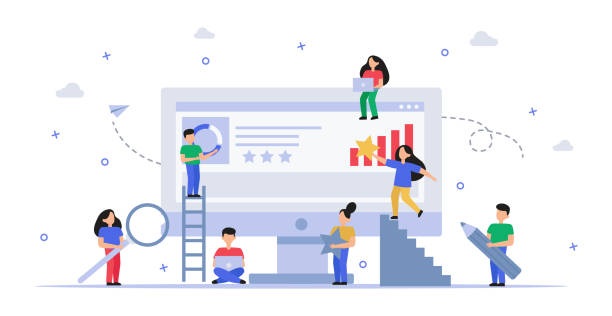
One of the most important steps in the process of modern UI website design is a precise and deep understanding of the target audience.
Who is going to use this website? What are their needs, goals, problems, and behaviors? Answering these questions is the cornerstone of effective user experience design.
User Research involves various methods such as interviews, surveys, statistical data analysis, persona creation, and User Journey Mapping.
By identifying user personas, we can design for real people with specific needs, rather than for a general and hypothetical user.
User journey mapping helps us examine each stage of user interaction with the site from their perspective, identify pain points, and find opportunities for improving the experience.
This specialized stage not only leads to a more user-friendly site but also significantly increases the return on investment in design.
Ignoring this stage can lead to the design of a product that does not meet the real needs of users, consequently facing a lack of reception.
Below are common user research methods:
| Research Method | Description | Benefits |
|---|---|---|
| User Interviews | In-depth conversations to understand needs and motivations. | Gain deep qualitative insights. |
| Surveys and Questionnaires | Collect quantitative data from a large number of users. | Quick and cost-effective evaluation. |
| Usability Testing | Observe users performing tasks on the site. | Identify practical problems and weaknesses. |
| Statistical Data Analysis (Analytics) | Using tools like Google Analytics to track user behavior. | Understand behavioral patterns on a large scale. |
The Role of Visual Elements in Creating an Unrivaled User Experience

Visual elements are the backbone of any modern UI website design and directly influence user perception and feelings.
The correct choice of colors, fonts, and images can distinguish your website from competitors and strengthen your brand identity.
The psychology of colors plays a significant role in evoking specific emotions in users.
For example, blue usually conveys a sense of trust and calmness, while red can communicate urgency or excitement.
A harmonious color palette, appropriate for the site’s theme, gives your website a professional and integrated look.
Typography, or the art of arranging type, is also of high importance.
Choosing readable and appropriate fonts for headlines and main texts significantly helps improve the reading experience.
Visual Hierarchy, meaning highlighting the most important information through size, color, and position, helps the user quickly grasp the content.
Using high-quality and relevant images and videos not only adds to the site’s beauty but can also convey your message more effectively.
In fact, a strong visual design can act as a non-verbal language, communicating your brand’s emotions and values to users.
These artistic and specialized aspects all lead to the enhancement of modern user experience and are indicative of an advanced website design.
Is your online sales not as you expect? With Rasaweb, solve the problem of low sales and poor user experience forever!
✅ Increase visitor-to-customer conversion rates
✅ Create an enjoyable user experience and boost customer trust
⚡ Act now for a free consultation!
Smart Interactions and Microinteractions in Modern Design

In the world of modern UI website design, small details can create big impacts.
Microinteractions are those small, subtle movements and feedback that occur when a user interacts with a website; for example, a button changing color when hovered over, a confirmation animation after submitting a form, or a progress bar appearing during content loading.
These small details not only add to the site’s visual beauty and appeal but also play a significant role in improving User Experience (UX).
They provide immediate feedback to the user, confirm their action, and instill a sense of control and satisfaction.
A well-designed microinteraction can prevent user confusion, reassure them, and even provide entertaining moments.
This approach means creating modern and interactive websites that keep users engaged.
Furthermore, smooth animations and transitions between pages or elements can convey a sense of speed and dynamism to the user and prevent environmental monotony.
Intelligent use of these elements gives your website personality and transforms it from a mere tool into an enjoyable experience.
This analytical approach to design ensures that every aspect of interaction is calculated and purposeful, contributing to creating an unparalleled user interface.
The Importance of Responsive Design and Mobile User Experience
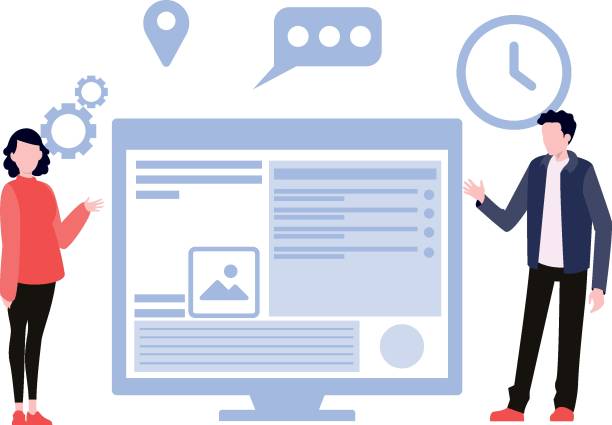
With the increasing use of mobile devices for internet access, modern UI website design would be incomplete without considering a responsive design approach.
Responsive design means that your website automatically adapts its size and layout to the screen dimensions of the device the user is using.
This provides a seamless and optimized user experience on any device, from smartphones and tablets to laptops and large monitors.
The absence of a mobile-friendly design can lead to user frustration, increased bounce rates, and ultimately the loss of traffic and customers.
Google has also long ranked mobile-friendly websites higher in its search results, so this is crucial for SEO.
In a responsive website, images are optimized, fonts are properly adjusted, and menus are designed to be accessible and usable on smaller devices (such as hamburger menus).
Beyond merely being responsive, it’s important to view Mobile UX as a priority.
This means simplifying processes, reducing typing, and utilizing touch gestures.
A professional and practical website design must pay special attention to these dimensions to provide excellent service to users in any environment.
Optimizing Performance and Accessibility for All Users
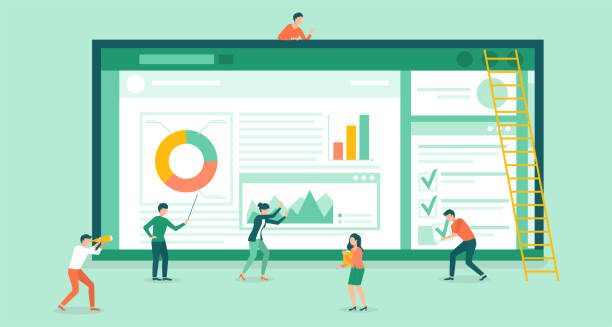
Another core pillar of modern UI website design is attention to Performance and Accessibility.
Website loading speed directly affects user experience.
Today’s users are impatient; if a website takes more than a few seconds to load, they will likely leave it.
Image optimization, code compression, using Content Delivery Networks (CDNs), and caching are among the important methods for increasing site speed.
On the other hand, accessibility means designing a website that is usable for everyone, including people with disabilities.
This includes using alt tags for images (for blind users who use screen readers), ensuring sufficient contrast between text and background (for people with visual impairments), keyboard navigation, and providing captions for video content.
Accessible design is not only an ethical and legal requirement but also expands your target market.
An advanced and inclusive website design demonstrates a business’s commitment to providing services to all segments of society.
This approach ensures that your site is usable and enjoyable for everyone, regardless of their abilities, which is one of the key features of modern website development.
| Aspect | Description | Key Points |
|---|---|---|
| Performance Optimization | Increasing website loading speed and responsiveness. | Image compression, code optimization, caching, using CDN. |
| Accessibility | Usability of the site for people with disabilities. | Alt tags for images, color contrast, keyboard navigation, captions. |
Test and Iterate: The Cycle of Continuous Improvement in Design
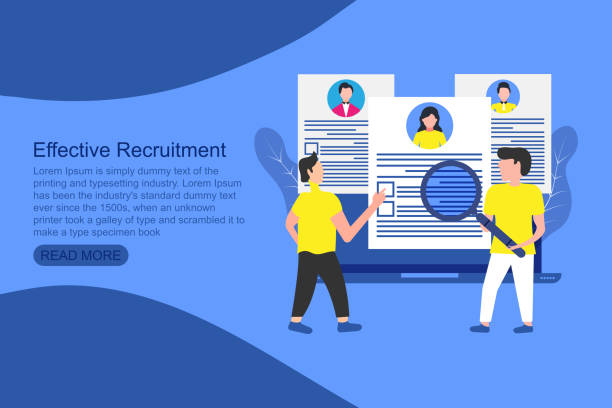
After the initial implementation of modern UI website design, the work is not over.
In fact, the design process is an iterative and continuous cycle that involves testing, gathering feedback, and continuous improvement.
No design is perfect in its first version; there is always room for improvement.
Usability Testing is one of the most important stages in this cycle.
In this stage, real users interact with the website, and designers and researchers observe their behavior and identify potential problems.
These tests can be conducted in-person, remotely, or using screen recording and eye-tracking tools.
In addition to qualitative tests, A/B tests can also be used, where two different versions of a page or element are shown to different groups of users to determine which version performs better.
User feedback through surveys, contact forms, and even social media is also very valuable.
All collected data and feedback should be analyzed to identify weaknesses and provide appropriate solutions for them.
Then, changes are applied, and the cycle is repeated.
This analytical and iterative approach ensures that your user-friendly site is always improving and keeps pace with changing user needs and new technologies.
This dynamic and responsive website design ensures long-term success.
Did you know your company’s website is the first point of contact for 75% of potential customers?
Your website is the face of your brand. With **Rasaweb**’s corporate website design services, build an online presence that earns customer trust.
✅ Create a professional and lasting image for your brand
✅ Attract target customers and increase online credibility
⚡ Get a free consultation from **Rasaweb** experts now!
New Trends in UI/UX Design for 2024 and Beyond

The world of modern UI website design is constantly evolving and innovating.
To stay at the forefront of these changes, one must be aware of new trends and incorporate them into designs.
One of the most important trends for 2024 is the increased focus on Dark Mode designs and night modes, which are not only beneficial for reducing eye strain but also help devices save battery.
Another is the broader use of Artificial Intelligence (AI) and Machine Learning (ML) for personalizing the user experience.
Sites can analyze user behavior to provide highly personalized content and suggestions.
Augmented Reality (AR) and Virtual Reality (VR) are also slowly making their way into advanced website design and can offer entirely new interactive experiences.
No-Code/Low-Code designs are also gaining popularity, enabling individuals without programming knowledge to create modern websites.
Focus on sustainability and Green Design, which helps reduce energy consumption and optimize server resources, is also highly important.
Finally, attention to inclusive user experience for all individuals, regardless of their abilities, will become a standard.
These trends show that user-friendly website design is constantly adapting to technologies and human needs, which is good news for the future of the web.
Visual Storytelling and Entertaining User Experience

One of the often-overlooked aspects of modern UI website design is its ability to tell a story (Storytelling) and create an entertaining experience.
A successful website is not just a source of information but a platform for interaction and creating an emotional connection with the user.
Visual storytelling, through the intelligent combination of images, videos, animations, and text, can immerse users in an engaging journey.
For example, a website might start with a stunning animation on the homepage, then gradually reveal the product or service story as the user scrolls.
Using Gamification, such as scoring systems, challenges, or small rewards, can increase user interaction and make their experience more enjoyable.
This approach is particularly effective for educational sites, social platforms, and entertainment applications.
The goal is for the user to feel part of a narrative, not just a visitor.
This entertaining element not only encourages users to stay on the site longer but also positively imprints your brand in their minds.
Ultimately, an interactive and engaging website design can increase site traffic and strengthen customer loyalty, which are key features of site UI improvement.
Frequently Asked Questions
| No. | Question | Answer |
|---|---|---|
| 1 | What does modern user interface in website design mean? | It means designing a website that has a beautiful, appealing, and up-to-date appearance, while also being easy, intuitive, and enjoyable for the user to use (emphasis on UX/UI). |
| 2 | What are the main features of a modern user interface? | Includes minimal design, sufficient use of whitespace, appealing typography, a harmonious color palette, high-quality images and icons, full responsiveness, fast loading speed, and appropriate use of animations and micro-interactions. |
| 3 | Why is having a modern user interface important for a website? | It improves user experience, increases visitor trust, reduces bounce rates, increases user time on site, strengthens the brand, and ultimately helps achieve business goals (such as sales or user acquisition). |
| 4 | What is the role of Responsive Design in modern user interface? | Responsiveness is a crucial component; a modern UI website must display correctly and perform optimally on all devices (mobile, tablet, desktop). |
| 5 | How does typography (font selection) affect modern user interface? | Appropriate typography enhances readability, defines information hierarchy, and plays an important role in creating a modern visual aesthetic consistent with brand identity. |
| 6 | What is the importance of using Whitespace in modern design? | Whitespace allows visual elements to “breathe”, prevents clutter, increases user focus on the main content, and creates a clean and professional look. |
| 7 | What role do Micro-interactions play in improving modern user interface? | Micro-interactions (such as a button changing color on click, displaying a form submission confirmation) provide visual feedback to the user, make site usage more interactive and enjoyable, and convey a sense of attention to detail. |
| 8 | What tools are used for modern user interface design? | Common tools include Figma, Sketch, Adobe XD, and even Prototyping Tools. |
| 9 | How can one ensure that a modern user interface is also Usable? | Through User Testing, gathering feedback from real users, adhering to Accessibility principles, and Intuitive Navigation. |
| 10 | Does modern design mean removing all graphical elements? | No, modernity means the intelligent and purposeful use of graphical elements, colors, images, and animations to create an appealing yet functional experience, not their unnecessary removal. |
And other services of Rasaweb Advertising Agency in the field of advertising
Smart Brand Identity: Designed for businesses seeking online growth through the use of real data.
Smart Data Analysis: A blend of creativity and technology for user interaction through marketing automation.
Smart Conversion Rate Optimization: A professional solution for increasing site visits with a focus on marketing automation.
Smart Link Building: An innovative platform for improving customer behavior analysis with precise audience targeting.
Smart Marketplace: A specialized service for increasing sales growth based on marketing automation.
And over hundreds of other services in the field of internet advertising, advertising consultation, and organizational solutions
Internet Advertising | Advertising Strategy | Advertorials
Sources
UI/UX Design Principles
Modern Web Design Trends
Beauty in Web Design
Comprehensive Guide to Site Design
? Are you ready for your business to be seen in the online world? Rasaweb Afarin Digital Marketing Agency, with years of experience and expertise in the digital field, is by your side to turn your dreams into reality. By providing innovative and creative solutions, including fast and optimized website design, professional SEO, social media management, and targeted advertising, we help you attract more audiences and experience sustainable growth. With Rasaweb Afarin, the future of your business begins today.
📍 Tehran, Mirdamad Street, next to Bank Markazi, Kazeroon Janoubi Alley, Ramin Alley No. 6

